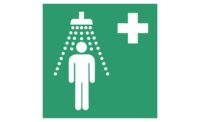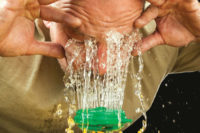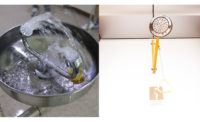Emergency showers and eyewash stations: Your guide to 2014 ANSI Z358.1 revisions & best practices

In an effort to establish minimum performance and use requirements for emergency eyewash and shower equipment, the American National Standards Institute (ANSI) created industry standard ANSI Z358.1 in 1981. This comprehensive guideline offers specific parameters for the appropriate design, installation, performance, certification, use and maintenance of emergency eyewash and shower safety equipment across a range of industries.
To keep up with changing environments and safety interpretations, ANSI Z358.1 was revised in 1990, 1998, 2004, 2009 and most recently, 2014. The latest revisions outline minor new specifications for the design, manufacture and installation of emergency showers, the location and accessibility of safety equipment installations and adjusted measurements.
- Function – The addition of Section 4.1.5, which states that “Emergency showers shall be designed, manufactured and installed in such a manner that, once activated, they can be used without requiring the use of the operator’s hands,” is intended to better enable a victim during the use of a shower. By requiring activation that is not manually operated, the victim is able to properly use a shower and thereby increase the effectiveness of the full 15-minute required flush.
- Installation & Measurements – Section 5.4.4 now mandates that eyewashes “be arranged such that the flushing fluid flow pattern as described in Section 5.1.8 is not less than 83.8 cm (33 in.) and no greater than 134.6 cm (53 in.) from the surface on which the user stands…” This is an eight-inch difference from the 2009 standard, which specified a distance no greater than 114.3 cm (45 in.). The same installation measurement change is seen in Section 6.4.4 pertaining to eye/face washes.
- Placement – The 2014 revision also addresses obstructions to emergency equipment, clarifying that “a single step up into an enclosure where the equipment can be accessed is not considered to be an obstruction.” This is found in Appendix B5.
Best practices
While ANSI compliance is a critical component to workplace safety, particularly as revisions are released, there are other considerations that must be made when the goal is to create a complete safety response environment. Accurate color coding, suitable site selection for emergency equipment, appropriate water temperatures, routine testing and ongoing training are all best practices that factor for victim comfort and ease of use before, during and after an emergency.
Accurate color coding for hazards in the workplace is a critical first step in minimizing unnecessary confusion during emergencies. ANSI Z535.1 specifies hazard color coding with designations for green as a safety, red as danger/stop, yellow as caution and orange as warning. Clear signage and employee familiarity with specific colors and their meanings will aid in both preventing an accident and providing direction to frightened, injured employees if the worst does happen.
While ANSI Z358.1 specifies appropriate distances from potential hazards for safety eyewash and shower equipment, these locations should also have adequate space for emergency responders. Tight quarters can reduce accessibility and negatively impact response time.
2009 revision of the standard specified that emergency eyewashes, eye/face washes and combination eye/face wash and shower units must deliver tepid water between 60° F to 100° F (16° C-38° C) for a full 15-minute drench period. However, low temperatures in this range fail to factor for the comfort of the victim. Water that is too cold reduces the likelihood that a victim will meet the full flush period or remove contaminated clothing, decreasing its effectiveness.
Inadequate employee training can likewise hamper the effectiveness of emergency safety equipment. Familiarity with procedures and protocols is critical for proper use in an emergency scenario to ensure that every employee can serve as his or her own best advocate and as a resource for others. And just as important as routine training is comprehensive weekly activation of all emergency equipment to ensure proper operation. While quick activations to check proper working order may seem sufficient, ensuring that a unit can meet its full 15-minute flush period is far more effective. Routine testing is intended to guarantee that every piece of safety equipment has the proper supply and flow of flushing fluid while simultaneously clearing the line of any sediment build-up. Weekly testing should also replicate real-life scenarios as much as possible. In addition, dedicated weekly testing helps streamline the annual testing process because safety personnel have been thoroughly evaluating the functionality regularly.
Lastly, victim comfort is of paramount importance when selecting an emergency shower or eyewash. The standard specifically states the units must provide a controlled flow of flushing fluid at a velocity low enough to be non-injurious to the user. Victim comfort helps create an environment where a user will be encouraged to flush for the full 15-minute time period. Water flow, pressure and proper directional patterns, as well as protective curtains or enclosures, will help provide an optimal environment for a victim.
Looking for a reprint of this article?
From high-res PDFs to custom plaques, order your copy today!






